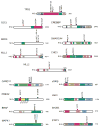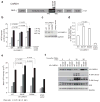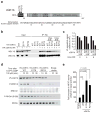The mutational landscape of cutaneous T cell lymphoma and Sézary syndrome
- PMID: 26551667
- PMCID: PMC4878831
- DOI: 10.1038/ng.3442
The mutational landscape of cutaneous T cell lymphoma and Sézary syndrome
Abstract
Sézary syndrome is a leukemic and aggressive form of cutaneous T cell lymphoma (CTCL) resulting from the malignant transformation of skin-homing central memory CD4(+) T cells. Here we performed whole-exome sequencing of tumor-normal sample pairs from 25 patients with Sézary syndrome and 17 patients with other CTCLs. These analyses identified a distinctive pattern of somatic copy number alterations in Sézary syndrome, including highly prevalent chromosomal deletions involving the TP53, RB1, PTEN, DNMT3A and CDKN1B tumor suppressors. Mutation analysis identified a broad spectrum of somatic mutations in key genes involved in epigenetic regulation (TET2, CREBBP, KMT2D (MLL2), KMT2C (MLL3), BRD9, SMARCA4 and CHD3) and signaling, including MAPK1, BRAF, CARD11 and PRKG1 mutations driving increased MAPK, NF-κB and NFAT activity upon T cell receptor stimulation. Collectively, our findings provide new insights into the genetics of Sézary syndrome and CTCL and support the development of personalized therapies targeting key oncogenically activated signaling pathways for the treatment of these diseases.
Conflict of interest statement
The authors declare no competing financial interests
Figures




References
-
- Querfeld C, Rosen ST, Guitart J, Kuzel TM. The spectrum of cutaneous T-cell lymphomas: new insights into biology and therapy. Curr Opin Hematol. 2005;12:273–8. - PubMed
-
- Wilcox RA. Cutaneous T-cell lymphoma: 2014 update on diagnosis, risk-stratification, and management. Am J Hematol. 2014;89:837–51. - PubMed
-
- Agar NS, et al. Survival outcomes and prognostic factors in mycosis fungoides/Sezary syndrome: validation of the revised International Society for Cutaneous Lymphomas/European Organisation for Research and Treatment of Cancer staging proposal. J Clin Oncol. 2010;28:4730–9. - PubMed
-
- Cristofoletti C, et al. Comprehensive analysis of PTEN status in Sezary syndrome. Blood. 2013;122:3511–20. - PubMed
-
- Mao X, et al. Heterogeneous abnormalities of CCND1 and RB1 in primary cutaneous T-Cell lymphomas suggesting impaired cell cycle control in disease pathogenesis. J Invest Dermatol. 2006;126:1388–95. - PubMed
Publication types
MeSH terms
Substances
Associated data
Grants and funding
LinkOut - more resources
Full Text Sources
Other Literature Sources
Medical
Molecular Biology Databases
Research Materials
Miscellaneous

